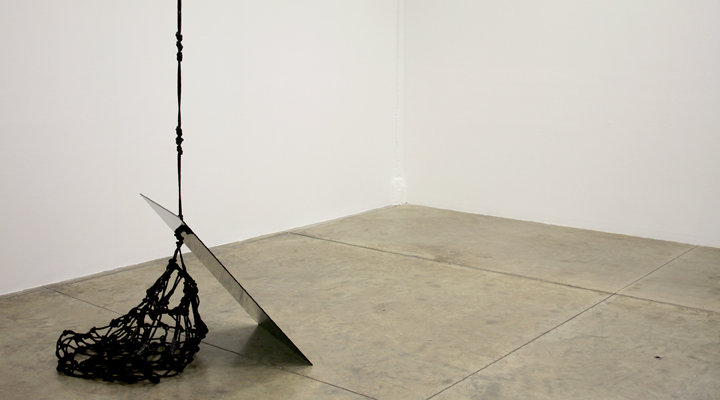






Natascha Snellman
Face Facade
May 14–June 26, 2010
Gender metaphors and archetypes mix with corporeal sensibilities in Natascha Snellman’s recent photographs and sculpture. Snellman’s works utilize surrogates from popular culture, the art world, and the animal kingdom to question relationships between animal and man/woman, man and woman, and the other. Her work has been included in both Other Arrangements (Organized by Diana Thater + Helen Varola, Pacifc Design Center, Los Angeles) and We Children of the Zoo (Rocksbox Contemporary Fine Art, Portland.) Snellman holds degrees from the Art Center College of Design, and the Pacific Northwest College of Art. Snellman’s exhibition continues the gallery's year-long collaboration with writer John Motley.
As part of a continued commitment to fostering vital discourse surrounding contemporary art, Fourteen30 Contemporary commissioned recent Creative Capital | Warhol Foundation Arts Writers Grant recipient John Motley to produce a critical essay for each gallery exhibition through the summer of 2010. Each essay appears as part of a limited quantity of offset printed posters, available at the gallery or by request. In an excerpt from his essay on Snellman, Motley writes:
“That Natascha Snellman lives and works in Los Angeles, where Hollywood seeps into the ruts of daily life under sunglasses and the lowered brims of ball caps, may explain how the artist began crosswiring ideas related to zoos and captivity with imagery shored from the endless photo stream of tabloid culture. After all, we monitor celebrities and movie stars, in particular, with the guiltless entitlement of watching animals pace their cages; we devour marital meltdowns, text message transcripts, and myth-deflating snapshots with the effortlessness of breathing.
Snellman’s sculptures and twodimensional work, which are largely predicated on appropriation, reflect this ravenous kind of looking. The work often employs materials related to zoos and animals (cages, python skin, and the faces of snarling jungle cats), but, like a python, it also swallows images whole, from photographs of celebrity sex symbols (Nastassja Kinski, Brigitte Bardot, Debbie Harry, et al) to similarly familiar forms, ideas, and figures throughout twentieth century art history.
This approach is like a collagist’s, in which the disjointed stimuli of the world are resuscitated through composition and context. Yet Snellman’s synthesis of captive animals, sexualized female celebrities, and Modernism’s mostly male legacy create a stage to address how the objectifying gaze defines us as subjects. When we look, we aspire to master the object of our scrutiny, to transform knowledge into subjugating ownership.
But, as Snellman’s work so often reveals, this relationship between subject and object is not so plainly parasitic. That the animals at the zoo are prisoners in their pens and cages is obvious, but the imprisonment of the watchers—who neither look away nor realize their gazes are never met—is covert, insidious. The dynamic spirals into an uneasy symmetry: the subject holds the object captive and is, in turn, captivated by it. When distinctions between empowerment and vulnerability blur, predator and prey may each be disguised as the other.”
Face Facade
May 14–June 26, 2010
Gender metaphors and archetypes mix with corporeal sensibilities in Natascha Snellman’s recent photographs and sculpture. Snellman’s works utilize surrogates from popular culture, the art world, and the animal kingdom to question relationships between animal and man/woman, man and woman, and the other. Her work has been included in both Other Arrangements (Organized by Diana Thater + Helen Varola, Pacifc Design Center, Los Angeles) and We Children of the Zoo (Rocksbox Contemporary Fine Art, Portland.) Snellman holds degrees from the Art Center College of Design, and the Pacific Northwest College of Art. Snellman’s exhibition continues the gallery's year-long collaboration with writer John Motley.
As part of a continued commitment to fostering vital discourse surrounding contemporary art, Fourteen30 Contemporary commissioned recent Creative Capital | Warhol Foundation Arts Writers Grant recipient John Motley to produce a critical essay for each gallery exhibition through the summer of 2010. Each essay appears as part of a limited quantity of offset printed posters, available at the gallery or by request. In an excerpt from his essay on Snellman, Motley writes:
“That Natascha Snellman lives and works in Los Angeles, where Hollywood seeps into the ruts of daily life under sunglasses and the lowered brims of ball caps, may explain how the artist began crosswiring ideas related to zoos and captivity with imagery shored from the endless photo stream of tabloid culture. After all, we monitor celebrities and movie stars, in particular, with the guiltless entitlement of watching animals pace their cages; we devour marital meltdowns, text message transcripts, and myth-deflating snapshots with the effortlessness of breathing.
Snellman’s sculptures and twodimensional work, which are largely predicated on appropriation, reflect this ravenous kind of looking. The work often employs materials related to zoos and animals (cages, python skin, and the faces of snarling jungle cats), but, like a python, it also swallows images whole, from photographs of celebrity sex symbols (Nastassja Kinski, Brigitte Bardot, Debbie Harry, et al) to similarly familiar forms, ideas, and figures throughout twentieth century art history.
This approach is like a collagist’s, in which the disjointed stimuli of the world are resuscitated through composition and context. Yet Snellman’s synthesis of captive animals, sexualized female celebrities, and Modernism’s mostly male legacy create a stage to address how the objectifying gaze defines us as subjects. When we look, we aspire to master the object of our scrutiny, to transform knowledge into subjugating ownership.
But, as Snellman’s work so often reveals, this relationship between subject and object is not so plainly parasitic. That the animals at the zoo are prisoners in their pens and cages is obvious, but the imprisonment of the watchers—who neither look away nor realize their gazes are never met—is covert, insidious. The dynamic spirals into an uneasy symmetry: the subject holds the object captive and is, in turn, captivated by it. When distinctions between empowerment and vulnerability blur, predator and prey may each be disguised as the other.”